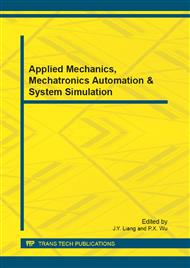[1]
R. Chellappa, Intermediaries in cloud-computing: A new computing paradigm, in INFORMS Dallas 1997 Cluster: Electronic Commerce, Dallas, Texas, (1997).
Google Scholar
[2]
Information on http: /aws. amazon. com.
Google Scholar
[3]
S. Lohr, Google and IBM join in cloud computing research, New York Times, (2007).
Google Scholar
[4]
D. Krissi, Distinguishing Cloud Computing from Utility Computing, Ebizq. net, information on http: /www. ebizq. net/blogs/saasweek/2008/03/distinguishing_cloud_computing.
Google Scholar
[5]
F. Chang, J. Dean, S. Ghemawat, W. C. Hsieh, D. A. Wallach Mike Burrows, et al. Bigtable: A Distributed Storage System for Structured Data, Proceeding of the 7th Symposium on Operating System Design and Implementation, Vol. 7, Seattle, WA, November, (2006).
DOI: 10.1145/1365815.1365816
Google Scholar
[6]
J. Dean and S. Ghemawat, MapReduce: Simplifed Data Processing on Large Clusters, Commun. ACM, vol. 51, pp.107-113, (2008).
DOI: 10.1145/1327452.1327492
Google Scholar
[7]
Information on http: /en. wikipedia. org/ wiki/Evaluation.
Google Scholar
[8]
J. J. Dongarra, P. Luszczek and A. Petitet, The LINPACK benchmark: Past, present, and future, Concurrency and Computation: Practice and Experience, 2003, vol. 15, p.1−18.
DOI: 10.1002/cpe.728
Google Scholar
[9]
D. Bailey, T. Harris, _ W. Saphir, R. Wijngaart, A. Woo and M. Yarrow, The NAS parallel benchmarks 2. 0, information on http: /www. nas. nasa. gov/assets/pdf/techreports/1995/nas-95-020. pdf.
Google Scholar
[10]
SPEC standards, information on http: /www. spec. org.
Google Scholar
[11]
E. Joseph, C. G. Willard, M. Swenson and D. Goldfarb, A new HPC technical computing benchmark: the IDC balanced rating, IDC Bulletin W IDC Bulletin #W24824, June, (2001).
Google Scholar
[12]
J. Dongarra and P. Luszczek, Introduction to the HPC challenge benchmark suite, ICL Technical Report, ICL-UT-05-01, (2005).
Google Scholar
[13]
J. A. McCall, P. K. Richards and G. F. Walters, Factors in software quality, RADC (Rome Air Development Centre): Technical Report RADC-TR-77-363, (1977).
Google Scholar
[14]
L. Zeng, Benat allam B. QoS aware middleware for Web service composition, IEEE Transactions on Software Engineering, 2004, 30(5), pp.311-327.
DOI: 10.1109/tse.2004.11
Google Scholar
[15]
B. Medjah ed, Semantic Web enabled composition of Web services, [ Ph. D. dissertation ]. Virginia Polyt echnic Institute and State University, Virginia, USA, (2004).
Google Scholar
[16]
W.J. Yang, J.Z. Li, K.H. Wang, Domain-Adaptive Service Evaluation Model, Chinese Journal of Computers, No. 4, Vol. 28, pp.514-523, (2005).
Google Scholar
[17]
G. Q. Liu, Z. L. Zhu, H. Wang, D. CH. Li and Y. Liu, Model for Evaluating QoS Trust worthiness of Web Service, Journal of Chinese Computer Systems, Vol. 30, No. 11, pp.2216-2221, (2009).
Google Scholar
[18]
Y. L. Liu, X. Y. Bai, G. Cheng and L. J. Wang, Policy-based runtime performance evaluation and validation of Web Service, ACTA ELECTRONIC ASINIC, vol. 32, no. 2A, pp.182-187, (2010).
Google Scholar
[19]
Information on http: /www. cjsdn. net/post/view?bid=2&id=4913&sty=3.
Google Scholar
[20]
J. Scanlon and B. Wieners. The Internet Cloud, Thestandard. com, information on http: /www. thestandard. com/article/0, 1902, 5466, 00. html. Retrieved 2010-08-22.
Google Scholar
[21]
B. Rochwerger, J. Caceres, R.S. Montero, D. Breitgand, E. Elmroth, et al. The RESERVOIR Model and Architecture for Open Federated Cloud Computing, IBM Journal of Research and Development, vol. 53, no. 4, (2009).
DOI: 10.1147/jrd.2009.5429058
Google Scholar
[22]
Ch. T. Chen and K. H. Lin, A decision-making method based on interval-valued fuzzy sets for cloud service evaluation, 4th International Conference on New Trends in Information Science and Service Science (NISS), pp.556-564, (2010).
Google Scholar
[23]
H. Kim, H. Lee, W. Kim and Y. Kim,A Trust Evaluation Model for Cloud Computing, Grid and Distributed Computing Communications in Computer and Information Science, vol. 63, pp.184-192, (2009).
DOI: 10.1007/978-3-642-10549-4_22
Google Scholar
[24]
J. Y. Lee, J. W. Lee, D. W. Cheun and S. D. Kim,A Quality Model for Evaluating Software-as-a-Service in Cloud Computing, 2009 Seventh ACIS International Conference on Software Engineering Research, Management and Applications,pp.261-266, (2009).
DOI: 10.1109/sera.2009.43
Google Scholar


